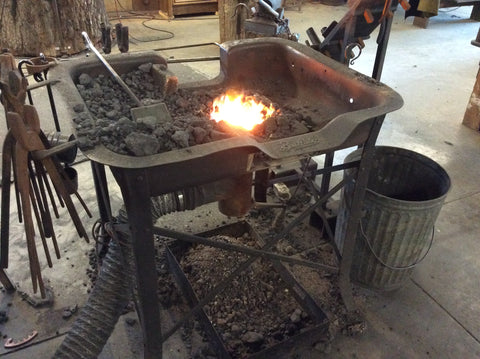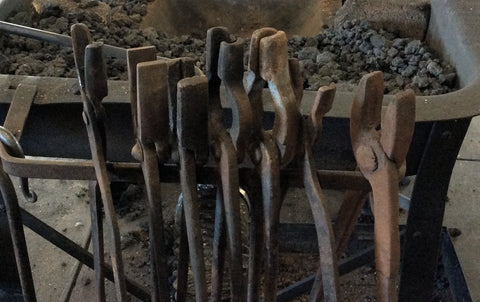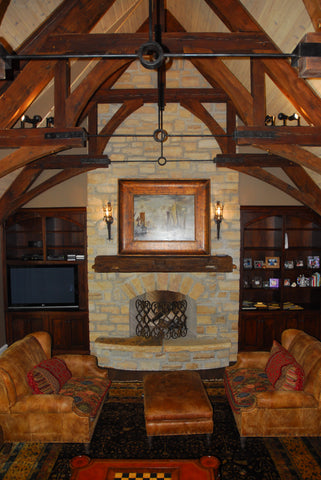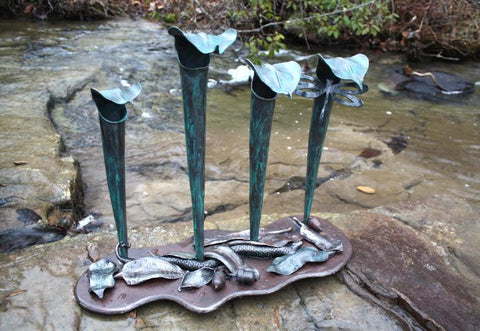This is a transcript of Walter's segment for Bama Bounce TV. Enjoy!
The Art of Black Smithing, Making a forged leaf hook.
The forge I'm working on is a Buffalo Forge built in the 1890's, it was originally built as a rivet forge, where both sides were high but the type work I do, long pieces and that sort of thing I had to go ahead and cut me a hole in that end and drop this end to where I could get the long stuff down on to the fire pot. It was given to me by a gentleman who had run our dairy farm for thirty five years and he just thought I would be interested in it and I have been using it ever since. It has been modified so I could work on it 8 hours a day but it is basically the same forge. The Buffalo Forge company is still in business but they now do big air handling systems for large plants and industries.
Explaining the hardy hole and hardy tools
The tools on this rack are what they refer to as your hardy tools they go in your square hole in the anvil which is called the hardy hole. I have made all my own tools. I basically use whatever I need to to get the shape I need, this isn't rocket science you are just heating up metal and bending it so I don't buy any tools, I make my own. I have made all my own tongs except for a couple of pair. I feel like doing that it makes you a better blacksmith also.
Hammering out a forged Leaf using no molds or templates
What I am fixing to do is just a decorative leaf hook to hang on wall. We will start here by making the leaf end first and just take you through the different steps and stages. The part I am fixing to hammer now will be the leaf tip, the tip of the leaf...(hammering and banging). All right theres the tip. We are going to reheat it and when we pull it out of the heat next time we are going to put a fuller in it. And basically the fuller, it give me a reference point on where the stem starts and the leaf starts.
When I come out of the fire this time I am going to do a square taper and we are going to start the process of making a round stem coming up to the leaf and it will take probably 2 or 3 heats maybe. (Bang, Clang, Repeat) Ok with this heat we are going to finish rounding out the stem and get that completed.
We do 90% custom work for homes, we do strapping for beam work in homes, we can do the old time strapping where we make it look like its 200 hundred years old, we can distress it with chains and hammers and that sort of thing and put the old time finish on also.
All right what I am fixing to do now, we are good and hot and I am going to pull it out and start flattening this slug on the end and we are going to make a leaf... (Bam, Bam, Bam, Bam, Clang...) Reheat.... All right we have to reheat for the third time. If anybody wondered the product I am burning is coke. And coke basically is coal with all the impurities burned out of it or removed from it, thats why you don't see any smoke and very little fire. And its about three times hotter than coal also but a whole lot cleaner. All right our leaf is just about ready.
All righty, I'm gonna make a straight vein in the leaf nothing fancy, let me get it chocked down here.
All right that completes our process of putting the vein in the leaf. The next process we are going to reheat and shape. I had really never done much sculpture at all and then we were asked to come and do a demonstration at Jacksonville States Little River Canyon Center, an 8 million dollar learning facility at the Little River Canyon and while we were there demonstrating one of the people that ran the facility came out and asked me if I could make a pitcher plant and honestly I had never heard of a pitcher plant. They went and brought us a bunch of pictures and I made one and I have been doing sculptures ever since. Thats probably what I enjoy more than anything, plant sculptures, trees and animals.
I would say that there are very few people who understand how slow this work is and the amount of energy put into the work to make it look the way it does.
Alright we have the shaping started, we're going to reheat again, bang, clang, tink, tink, tink.. and there is our completed leaf.
All righty what we're fixing to do now, we are going to put a fish tail on the bottom where the hook is...bang, bang, bang, tink, tink, tink... hammer the fish tail around....All right the next step in the process we are going to be putting a twist in it. The last step in the process we are going to bend the stem, get the stem shaped. There's our finished piece.

We hope you enjoy the video and learn a little something old. You can see more videos of Walter on his You Tube Channel.
https://www.youtube.com/channel/UCXSEuhRGp_BXeBc-1mgVf4w
Videographer, editor and producer Mic Stowe
We will Praise Him with the Anvils Ring
Keep on Sparking!







